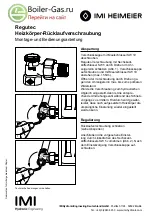
Matrix Installation and Operation Instructions
49
Call for Heat (24VAC @ W1) –
Normal Thermostat call, Matrix operates as a step-modulating furnace as
described above. If HRV set to ‘ON’, HRV will operate at the low (continuous) ventilation rate.
Call for Auxiliary Heat (24 VAC @ W2) –
When calling, furnace will provide heat at a stage 10 output rate.
With a call for auxiliary heating the Matrix will function as a single stage, full fire appliance. This means the
burner will come on with a thermostat call and go off when the call is satisfied. If HRV set to ‘ON’, HRV will
operate at the low (continuous) ventilation rate.
Outdoor Sensor –
The auxiliary heating function (24VAC @ W2) will utilize the outdoor sensor if available.
The outdoor reset function is not used for W1 heating. This function is also active during a hydronic heat
demand (24VAC @ H).
Plenum Sensor –
The Matrix is equipped with a plenum temperature sensor that must be field installed in the
supply plenum and wired to the furnaces external terminal strip. When installed the Matrix fan control
displays the plenum temperature and will use it to detect problems in the supply of heat to the space.
Call for Circulating Fan (24VAC @ G) –
Matrix operates at the programmed air circulation rate according to
the “FAN” setting in the Fan (blue) controller (400-1600 CFM). If HRV is set to ‘ON’ (see Section 13.0), the
HRV will ventilate at the low (Continuous) ventilation rate.
Call for Dehumidification (24VAC @ DH) –
Matrix operates at the minimum air circulation rate (400 CFM).
HRV will ventilate at the high (Override) ventilation rate.
Call for Cooling Fan (24VAC @ Y1):
Matrix operates at the prescribed air circulation rate (Y1x10 CFM – see
Section 13.0). HRV will not operate during a call for cooling unless there is a concurrent call for DH –
Dehumidification or G – Continuous and HRV is set to ON.
Call for Cooling Fan (24VAC @ Y2):
Matrix operates at the prescribed air circulation rate (Y2x10 CFM – see
Section 13.0). HRV will not operate during a call for cooling unless there is a concurrent call for DH –
Dehumidification or G – Continuous and HRV is set to ON.
Duct Sizing
When sizing ductwork, a maximum flow velocity of 800 fpm is
desired. Table 14-2 shows common duct sizes at specified
flows. The maximum flows that can be expected are shown in
Table 14-3. It is important to maintain the return plenum
pressure as low as possible. Keeping this ductwork as free
flowing as possible will offer more supply static pressure to
overcome A/C coils, closed registers, etc while maintaining
constant flow.
Any additional filtration, humidification, or de-humidification
equipment should be installed external to the return or supply
ducts so not to create additional restriction.
Table 14-3 Maximum Air Flow Rates
Fan Control Setting
Heating
(HEA)
Cooling
(COO)
ESPmax*
CFM
160 max
.35 inwg
1600
160 max
.6 inwg
1500
160 max
.75 inwg
1400
120 (3 Ton)
1200
80 (2 Ton)
800
PF3
No Cooling
<1 inwg
1200
PF2
No Cooling
<1 inwg
1100
PF1
No Cooling
<1 inwg
1000
Example #1
No cooling function with Heating
profile of PF2 selected. Maximum airflow will be
1100 CFM.
Example #2
Cooling set to 800 CFM for 2 tons of
cooling with Heating profile of PF3 selected.
Maximum airflow will be greater of cooling or heating
function. Maximum 1200 CFM.
*Measured from return plenum to supply plenum
prior to A/C coil. ECM motor can produce near
constant flow provided horsepower or maximum
speed of motor is not exceeded.
Airflow
(CFM)
Area
(sqft)
Duct Sizing
(inches)
1600
2
24x12
20x16
1200
1.5
24x10
20x12
18x12
1000
1.25
20x10
18x10
16x12
800
1
18x8
16x10
12x12
Table 14-2 Duct Size vs. Air Flow
Based on 800 fpm max airflow velocity
















































